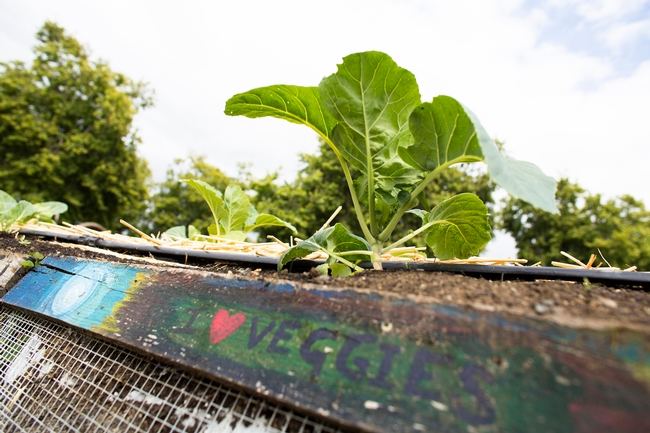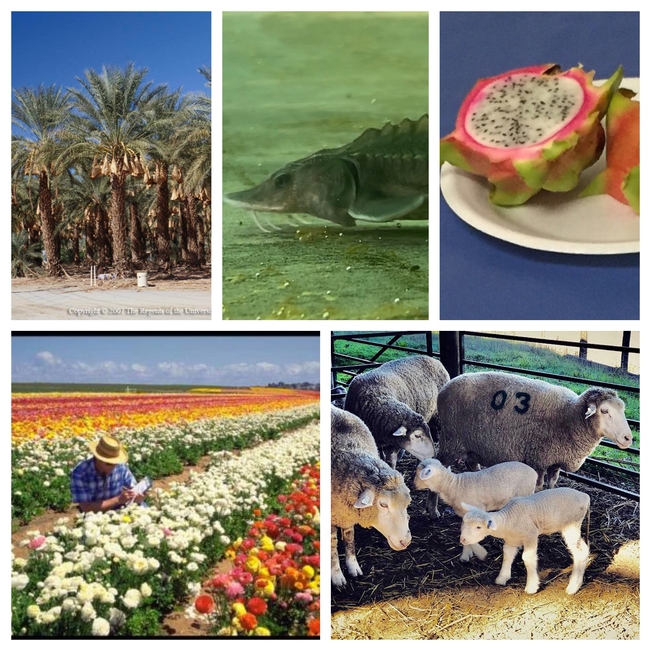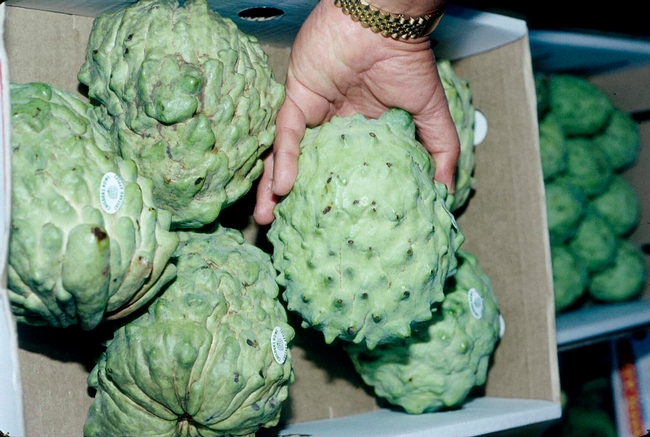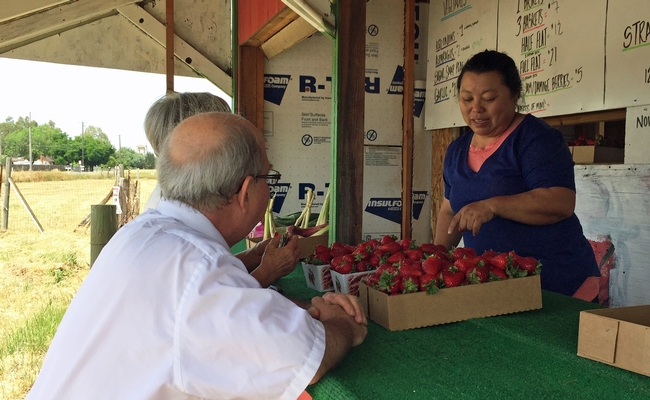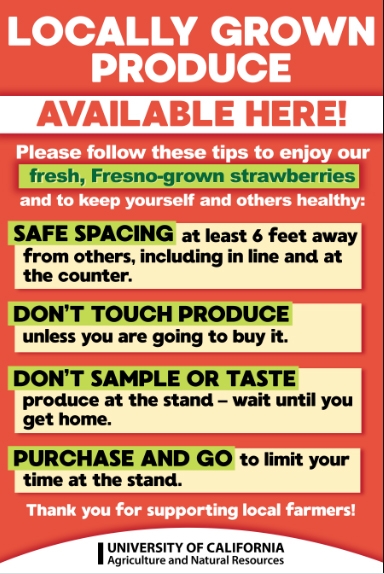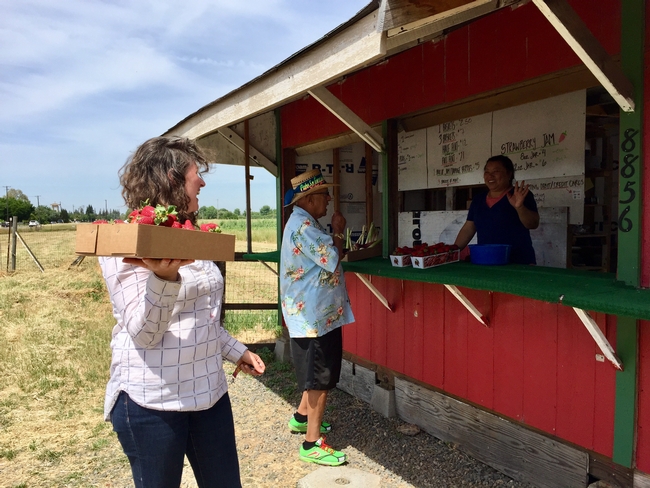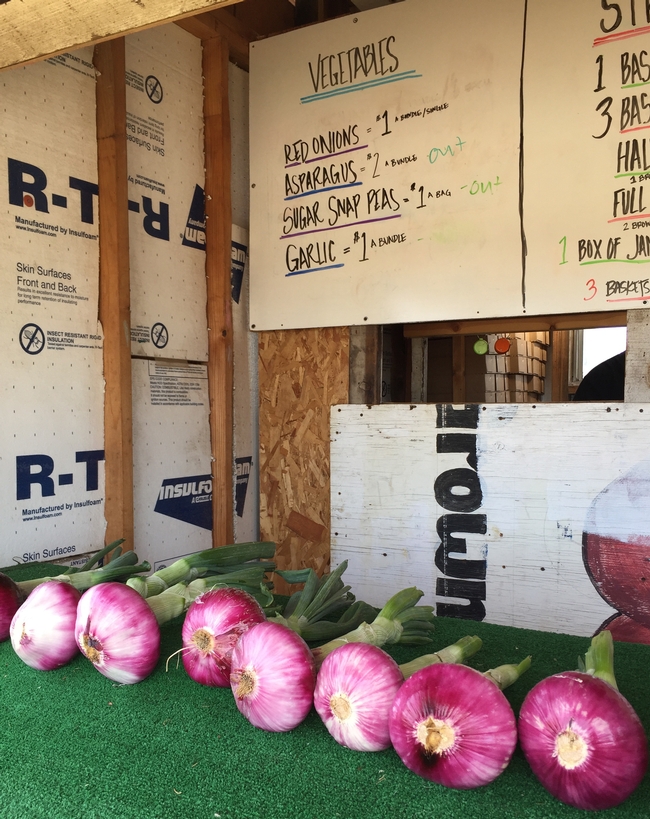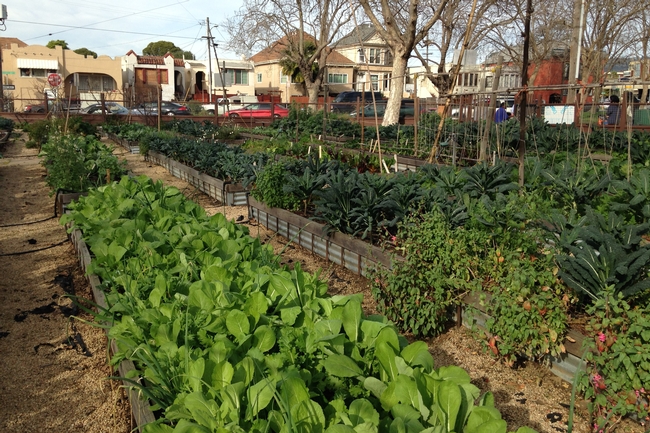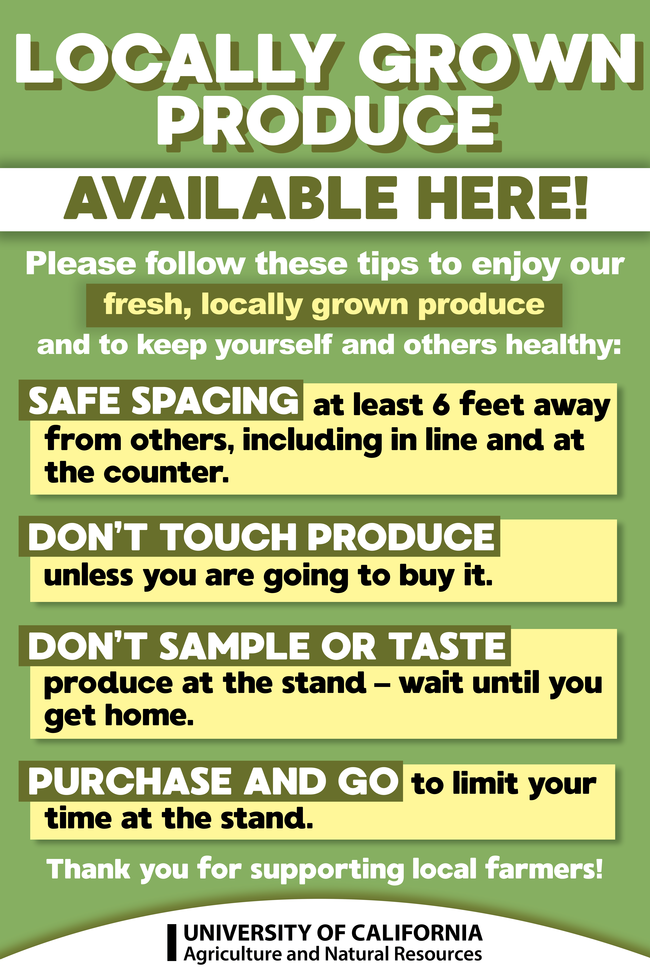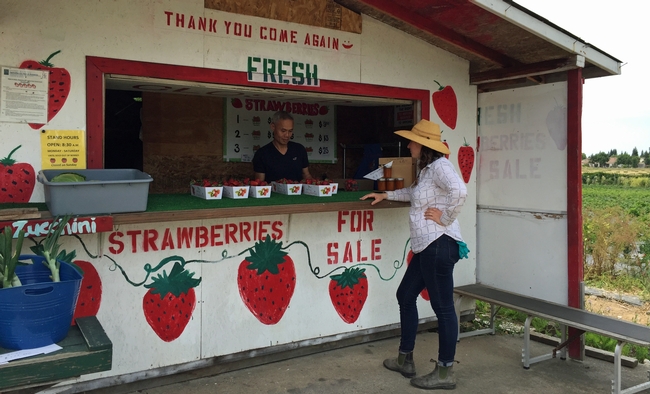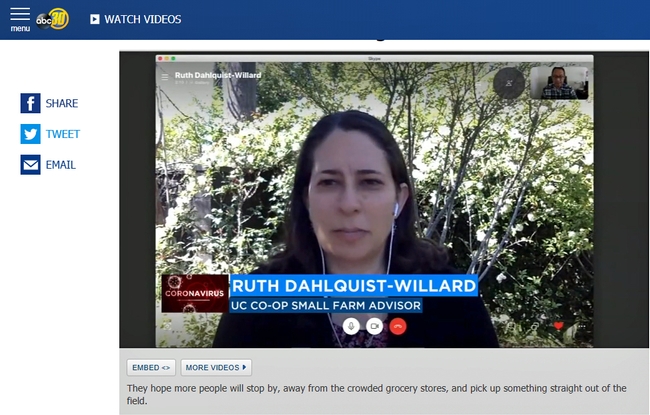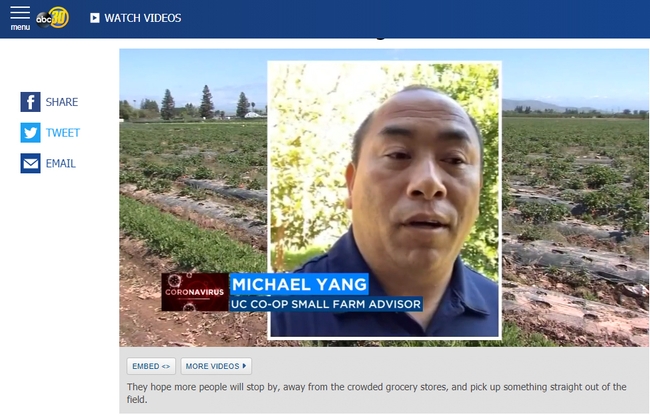Posts Tagged: Ruth Dahlquist-Willard
UC SAREP awards grants for sustainable food-systems research and outreach
The University of California Sustainable Agriculture Research & Education Program — a statewide program of UC Agriculture and Natural Resources — announced the recipients of its 2021 Sustainable Agriculture and Food Systems Small Grants Program today (April 13, 2021).
The grants program, which was reinstated this year after a 10-year hiatus, supports pilot projects focusing on strengthening California's sustainable agriculture and food systems. Together, 11 recipients are receiving $77,000 in funding to support their work.
"Many groups have innovative ideas on how to build a more profitable, environmentally sustainable and just food system in California, but they often need seed funding to get those ideas off the ground,” said Glenda Humiston, University of California vice president for agriculture and natural resources. “That's what UC ANR and UC SAREP are bringing to the table with these small grants: an opportunity to bring a creative idea to fruition."
The recipients of this year's grants are:
Agricultural and Land-Based Training Association, to pilot an agricultural plastics recycling program among primarily Spanish-speaking small-scale producers. (Project lead: Nathan Harkleroad)
California State University, Fresno, to evaluate the effect of cover crops on water demands and weeds in table grape vineyards in the Eastern San Joaquin Valley. (Project lead: Anil Shrestha)
Napa Farmers Market, to communicate the importance of locally and sustainably grown produce from farmers of diverse backgrounds through a bilingual educational campaign. (Project lead: Cara Wooledge)
Red Bluff Joint Union High School District, to teach high school students environmentally regenerative agriculture and leadership skills through its School Garden to Cafeteria project. (Project lead: Marissa Stevens)
San Diego Second Chance Program, to offer classes and workshops on sustainable agriculture for low- to middle-income youth with prior involvement in the juvenile justice system. (Project lead: Caelli Wright)
Santa Rosa Junior College, to add hibiscus products and mutual-aid garden kits to a bilingual mobile herb clinic that offers culturally relevant holistic health programs to Latinx and Indigenous populations. (Project lead: Heidi Hermann)
UC Agriculture and Natural Resources, to study the effects of livestock guardian dogs on wildlife species and the potential for conflict with recreationists. (Project lead: Carolyn Whitesell)
UC Cooperative Extension in Fresno County, to develop an equipment share program for equipment needed to apply compost on small-scale, diversified vegetable farms operated by socially disadvantaged farmers in Fresno County. (Project lead: Ruth Dahlquist-Willard)
UC Cooperative Extension in San Bernardino County, to provide interactive nutrition education classes, gardening lessons, and food safety and preservation demonstrations for ethnically diverse and limited-resource residents in San Bernardino County. (Project lead: Christine Davidson)
UC Davis, to build a team of researchers and community groups to develop a research and extension program to support beginning and first-generation ranchers in building resilience to environmental, economic, and social shocks and stressors. (Project lead: Leslie Roche)
UC Santa Cruz, to translate instructional videos on organic growing skills and practices into Spanish and to pilot a short course with Spanish-speaking trainees. (Project lead: Stacy Philpott)
“We're excited to watch these projects unfold over the coming year,” said Gail Feenstra, director of UC SAREP.
“This grant program isn't just important for supporting new ideas. It's also an opportunity for the University of California to build stronger connections with producers and other food system stakeholders across California. Those connections are essential for making the research and education that comes out of the university benefit everyone.”
UC SAREP was established in 1986 to strengthen California's agricultural production and supply chains to advance knowledge of the science of sustainability, support farmers and ranchers to develop more sustainable farming practices and assist communities to build healthy regional food systems.
More California farmers eligible for USDA Coronavirus Food Assistance Program funds
UC ANR experts available to comment
California farmers stand to benefit from the addition of more commodities now covered by the USDA Coronavirus Food Assistance Program, say UC Agriculture and Natural Resources experts. Yesterday (Aug. 11) the U.S. Department of Agriculture expanded eligibility and extended the deadline to apply to Sept 11.
Farmers of aquaculture, nursery crops and flowers, sheep and specialty crops such as dates, dragon fruit, nectarines, pomegranates, pumpkins and many other specialty crops grown in California are now eligible for financial assistance to help keep their operations afloat during the business disruption caused by the pandemic.
Below are UC Cooperative Extension advisors and specialists who are available for comment:
Daniel Macon, UC Cooperative Extension livestock and natural resources advisor serving Placer, Nevada, Sutter and Yuba counties, dmacon@ucanr.edu
“Including all sheep will be HUGE for California producers. Most California lambs are born in the fall and marketed in the late spring. The rest of the West has lambs born in the spring and marketed in the fall/winter/early spring. The original CFAP payments provided a maximum payout to lambs that would have been marketed earlier than most California lambs. And provided no payment for what we call running-age ewes (breeding animals).”
Jackson Gross, UC Cooperative Extension aquaculture specialist at UC Davis, jagross@ucdavis.edu
“This is a big distinction for our California freshwater fish producers. While it doesn't cover all of the diversity in California aquaculture, it does cover the majority of our industry as far as freshwater fish producers. A specialty crop distinction is important for our fish farmers, making them eligible for specialty crop funding and numerous other federal and state programs that were previously inaccessible.”
Cheryl Wilen, director of UC Cooperative Extension in San Diego County, cawilen@ucanr.edu
“It is my impression that ornamental nurseries will really have a good opportunity to recover money for unsold crops.”
Ruth Dahlquist-Willard, UC Cooperative Extension small farms and specialty crops farm advisor for Fresno and Tulare counties, rdwillard@ucanr.edu
"The addition of crops such as bok choy, daikon, winter melon, and turmeric expands the program to include more of the specialty produce grown on small-scale Southeast Asian farms in the Central Valley. However, highly diversified farms may find it difficult to apply for small acreages of multiple crops, and with USDA offices operating remotely, additional technical assistance is needed to support farmers with the application process."
Ramiro Lobo, UC Cooperative Extension small farms and agricultural economics advisor in San Diego County, relobo@ucanr.edu
“The specific mention of minor crops can be significant for small-scale growers in the state, and Southern California in particular for growers of crops like dragon fruit, and other minor subtropicals because it legitimizes them as commercial crops.”
Aparna Gazula, UC Cooperative Extension small farms and specialty crops farm advisor for Santa Clara, San Benito, and Santa Cruz counties, agazula@ucanr.edu
“It's great that the USDA Coronavirus Food Assistance Program has been expanded to include more minor crops. I hope the USDA offices have bilingual staff who can work with socially disadvantaged farmers with language barriers that often grow these crops.”
Aliasghar Montazar, UC Cooperative Extension irrigation and water management advisor in Imperial and Riverside counties, amontazar@ucanr.edu
“Maintaining date palms over the season is very labor oriented. During February to May, a lot of activities need to be conducted at a certain time. As you know, we had high pressure from the pandemic in the Coachella Valley during these months. It made labor less available, which created some challenges for growers.”
Mae Culumber, UC Cooperative Extension nut crop advisor in Fresno County, cmculumber@ucanr.edu
“Almonds, pistachios and walnuts commodities all suffered a price decline between mid-January and mid-April as a result of the COVID-19 pandemic. Thirty to 50 percent of the previous season's crop is normally marketed during this time of the year. The CFAP program will provide financial relief for losses due to price decline and spoiled shipments that lost a marketing channel due to the pandemic. Commodity boards are working with the Farm Service Agency to assist producers in applying for the program.”
Roadside strawberry stands offer particularly flavorful fruit
Central Valley residents from Visalia to Sacramento look forward every year to the beginning of strawberry season in early April, when roadside strawberry stands operated by Hmong and Mien farmers open to the public.
These farms grow strawberry varieties such as Chandler and Camarosa that haven't traded flavor for shelf life – they don't ship or store well, but they are far sweeter than varieties usually sold in stores, and they reach their peak ripeness and flavor in the fields next to the strawberry stands.
As strawberry season opens this year, farmers are hoping that customers will still stop by the stands to pick up their fresh, seasonal strawberries, and also that they will observe 6-foot social distancing and other guidelines to reduce the spread of COVID-19. UC Cooperative Extension agricultural assistant Michael Yang and I were interviewed on a local news station to encourage Fresno residents to practice these guidelines while supporting local farmers.
To assist Fresno strawberry farmers, the UCCE small farms team in Fresno County developed, printed, and distributed signs for roadside strawberry stands reminding customers to observe social distancing and other safety practices, as well as guidelines for farm stands to reduce the spread of COVID-19. Versions of the signs were also developed for strawberry stands in Merced and Sacramento, as well as a general sign for local produce at any farm stand.
Signs and safety guidelines were printed with funding from the Western Extension Risk Management Education Center, and Michael Yang distributed large printed versions of the signs to all strawberry stands on the Fresno County Fruit Trail map in Fresno County. These materials have also been shared with UCCE small farms and food systems advisors as well as nonprofit and agency partners and county Agricultural Commissioner's offices, and they are available for printing on the UCCE Fresno strawberry website.
Urban ag supplies fresh fruits and vegetables, part of a healthy diet
Even as Californians shelter in place to contain the novel coronavirus that causes COVID-19, nutritious food remains vital to the health and well-being of our communities.
“Eating fruits and vegetables is known to benefit our overall health and help our immune system,” said Lorrene Ritchie, director of the UC Nutrition Policy Institute. “At a time when we need to be especially vigilant about staying healthy, eating healthy is essential.”
Farms, farm stands and farmers markets are listed as “essential businesses” in the state shelter-in-place order because they are important parts of the food supply. Urban farms are included in this category. As large produce distributors struggle to switch from selling large quantities to restaurants, schools and institutions to supplying supermarkets, these small businesses may offer a better selection of fresh foods, and may be closer to homes and less crowded.
To help minimize exposure and risk of spreading of the virus, urban farms need to follow some key guidelines from the CDC , said Jennifer Sowerwine, UC Cooperative Extension metropolitan agriculture and food systems specialist in the Department of Environment, Science, Policy and Management at UC Berkeley.
UC Cooperative Extension has compiled a list of resources for farmers, community gardeners and other people working in the food system to ensure that they can continue supplying fresh, healthy and affordable food to Californians.
“Social distancing, heightened health and hygiene practices and cleaning and disinfecting reduce the risk,” said Sowerwine.
Although eating a nutritious diet can boost our immunity, the Los Angeles Times reported produce sales plummeted by 90% or more at Southern California produce markets after the statewide shelter-in-place rules went into effect.
“It's worrisome to see that sales of fruits and vegetables are dropping so sharply, but not surprising,” said Rachel Surls, UC Cooperative Extension sustainable food systems advisor for Los Angeles County. “As people shop during the crisis, they may be prioritizing groceries that can be stored for a longer time in the fridge or pantry. And they may be on a very limited food budget, even more so than usual, so they are likely prioritizing essentials like bread and rice and baby formula.”
To support farmers in California, the UC Sustainable Agriculture Research and Education Program created a directory at http://www.calagtour.org for consumers to find local farms to purchase produce directly.
For families who have lost jobs and income, the risk of food insecurity increases. Some families could supplement their food from gardens and urban agriculture during this crisis.
Consumers must practice safety, too, when visiting farmers markets and farm stands. UC Cooperative Extension small farm advisor Ruth Dahlquist-Willard explained, "Things like keeping the minimum six-foot distance from customers, not touching any produce that you're not planning to buy, leaving as soon as you've made a purchase and washing the produce when you get home would be some good guidelines."
The virus is thought to be spread mainly from person to person, however there is evidence that COVID-19 can last for days on hard surfaces, thus the need to ramp up good health and hygiene practices, social distancing and cleaning and sanitizing of surfaces.
University of California research and extension faculty have compiled a list of helpful fact sheets and resources for farmers, community gardeners and other food system workers to ensure fresh, healthy and affordable food for communities across the state:
- Food-related resources for consumers and members of the food industry for COVID-19
- on the UC Davis Food Safety website.
- Sowerwine's PowerPoint presentation Safe Handling Practices for Fresh Produce in a Time of Coronavirus Disease 2019 (COVID-19) for urban farmers.
- A set of policies and procedures for safe food handling at the farm during COVID-19 provides step-by-step instructions for applying new food and health precautions on the farm including checklists, standard operating procedures and signage posting guidelines for preventing the spread of infection.
- COVID-19 safety guidelines for farm stands.
- Handouts for safe food-handling at home that can be distributed to customers receiving food from the farm.
All of these resources are posted on the UC Urban Agriculture website at https://ucanr.edu/sites/UrbanAg.
“During this challenging time, I am heartened by the quick and thoughtful responses by many extension, grassroots and institutional efforts, including Community Alliance with Family Farm's COVID-19 Responses and Resources for California Family Farms, Mutual Aid organizations where groups of young, healthy and lower-risk people are bringing food and services to vulnerable people who shouldn't be in public at all, and Bayareafood.info that seeks to support local restaurants, farmers, and food systems workers as they weather this latest storm,” said Sowerwine. “Crisis can spawn innovation, and I am hopeful that through this, we will come out the other end with a more compassionate and resilient food system.”
Strawberry farm stands are gearing up for the 2020 season
Road side stands selling fresh strawberries and vegetables are opening up around the San Joaquin Valley, and are a excellent option for safe shopping, reported Dale Yurong on ABC 30 News in Fresno.
In keeping with social distancing guidelines, Yurong conducted remote interviews with UC Cooperative Extension advisor Ruth Dahlquist-Willard and agricultural assistant Michael Yang, who work closely with small-scale farmers in Fresno and Tulare counties.
Dahlquist-Willard suggested customers maintain a six-foot space from other shoppers at farm stands and follow other common sense precautions when purchasing the healthful fresh food by, "not touching any produce that you're not planning to buy, leaving as soon as you've made a purchase and washing the produce when you get home . . . . Similar to what we're seeing at farmers markets right now."
Some valley farmers have been selling their produce at farmers markets out of town and have noticed fewer people are out shopping, Yurong said. They hope more people will stop by the local farm stands, away from the crowded grocery stores, and pick up something straight out of the field.
"My farmers that go to farmers markets, even though the farmers market is still open, they only allow a few people at a time. You don't have a lot of customers walk by just like before," Yang said.
San Joaquin Valley strawberry stands were all expected to be open by April 10, Yurong said.

